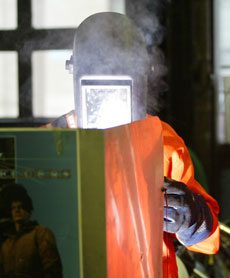Cuts pose threat to vocational courses

Online Poster
March 9, 2005
Carlos Arriaga-Gonzalez sighs from the effort of pumping a jack to lift a car so he can rotate its tires.
“Now what is that called?” Ed Nieman, vocational technology teacher at Champaign Central High School, asks Arriaga-Gonzalez, pointing to a part on the station wagon’s well-worn Goodyear tire.
“A tire nut?”
“No, a lug nut,” Nieman says. “What is that called?” He now points to the lug wrench in Arriaga-Gonzalez’s hands. Arriaga-Gonzalez shrugs his shoulders as his teacher tells him the correct answer.
Arriaga-Gonzalez, a senior who emigrated from Mexico with his family, is still struggling with some of the terminology, but he is excited that he will start in Parkland College’s auto mechanics program after he graduates from Central High School in May.
Get The Daily Illini in your inbox!
Turning to community colleges for technical training is nothing new. But costs are rising for vocational technology programs at the high school level and if President George W. Bush’s proposed 2006 budget passes, programs such as the one at Central could be at risk.
Bush’s budget proposal would cut all funding to the Carl Perkins Act, the main source of income for career and technical education programs, said Carol Lanning, senior director for program planning and accountability for the Illinois Community College Board. This act focuses on programs based in community colleges, but also funds most high school programs.
Instead, the budget proposal would give $125 million to fund community college classes that high school students choose to take, including more academically focused classes for students who plan to go on to four-year colleges and universities, Lanning said.
Parkland has an average of 600 students in its dual enrollment program each semester, said Larry Taylor, Tech Prep coordinator for the college. The majority of students take the classes to meet general education requirements for when they transfer to other schools, Taylor said.
Other financial issues affect technology education at the high school level.
Mike Daugherty, coordinator of technology teacher education at Illinois State University, said 30 percent of technology educators leave the profession within the first five years because they can make more money in other professions. This is one of the reasons why there are teacher shortages in subjects like math, science and technical fields at the high school level.
Two teachers, Nieman and Barry Mink, lead auto shop classes at Central this semester. Both are teaching the class for the first time. For Nieman, a self-described “Jack-of-all-trades,” teaching the class is fairly simple. He has a comprehensive degree in technical education that taught him the basics of auto mechanics as well as carpentry and other fields.
Mink, the other instructor, is having a harder time. He was an architect before he became a teacher. While his background made it an easy transition to teach drafting and graphic design classes, auto shop was another story.
Mink took a welding class at Parkland College in the fall to prepare him for teaching auto shop. He said he tries to keep several lessons ahead of the students so he will know how to answer their questions when it comes to the small engine repair component of the class.
“Unfortunately you don’t always get to teach in your strongest area,” Mink said.
Teachers at Central make an effort to keep costs down so that technology classes will remain affordable for the school district. The garage where auto shop classes are held is littered with more than 80 old lawnmowers, donated for the school’s students to take apart over the course of the semester.
In addition to the donations of mowers and the cars for auto classes, creative scheduling also saves money. In order to offer a class, the school district requires that 15 students enroll, Nieman said. In many cases students taking their second or third class in a specific subject area are placed in the same class to make it easier to meet the 15-student minimum.
Some are concerned mandates like No Child Left Behind and state requirements in the fields of math, technology and engineering could threaten traditional vocational education programs. Nieman said classes where computers are used are automatically deemed more high tech and therefore are less likely to be cut than other industrial technology classes.
Sean McLaughlin, system director for the Education for Employment system in Champaign, Douglas, Ford and Piatt counties said he fears the combination of proposed federal budget cuts and the No Child Left Behind Act could cut funding for vocational classes. Electives are the first classes to be cut if a school loses funding.
Daugherty looked at No Child Left Behind as a positive challenge.
“It is an accountability bill,” he said. “It’s irritating to educators, forcing the issues – forcing schools and educators to get the right certification and forcing the issue that all students should achieve. Right now schools aren’t really set up to accomplish that.”
Daugherty suggests including more reading and math in technical courses.
Others think it is the societal push for everyone to go to college that leads to diminished funding and decreasing interest in vocational programs.
“There is a stigma – who wants to get their hands dirty?” Nieman said.
Still, there are students who take advantage of industrial technology classes and plan to pursue education and careers in technical fields.
“I told Mr. Nieman I like cars and he told me about the program at Parkland,” Arriaga-Gonzalez said. “I start right after graduation; I don’t want to lose any time.”






